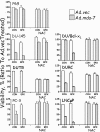Strategy for reversing resistance to a single anticancer agent in human prostate and pancreatic carcinomas
- PMID: 17360670
- PMCID: PMC1805584
- DOI: 10.1073/pnas.0700042104
Strategy for reversing resistance to a single anticancer agent in human prostate and pancreatic carcinomas
Erratum in
-
Correction for Lebedeva et al., Strategy for reversing resistance to a single anticancer agent in human prostate and pancreatic carcinomas.Proc Natl Acad Sci U S A. 2022 May 24;119(21):e2204209119. doi: 10.1073/pnas.2204209119. Epub 2022 May 18. Proc Natl Acad Sci U S A. 2022. PMID: 35584122 Free PMC article. No abstract available.
Abstract
Effective therapies for most solid cancers, especially those that have progressed to metastasis, remain elusive because of inherent and acquired resistance of tumor cells to conventional treatments. Additionally, the effective therapeutic window for many protocols can be very narrow, frequently resulting in toxicity. The present study explores an anticancer strategy that effectively eliminates resistant cancer cells without exerting deleterious effects on normal cells. This approach employs melanoma differentiation-induced gene-7/interleukin-24 (mda-7/IL-24), a cancer-specific, apoptosis-inducing cytokine, in combination with nontoxic doses of a chemical compound from the endoperoxide class that decomposes in water generating singlet oxygen. This combinatorial regimen specifically induced in vitro apoptosis in prostate carcinoma cells, with innate resistance to chemotherapy or engineered resistance to mda-7/IL-24, as well as pancreatic carcinoma cells inherently resistant to any treatment modality, including mda-7/IL-24. Apoptosis induction correlated with increased cellular reactive oxygen species production and was prevented by general antioxidants, such as N-acetyl-l-cysteine or Tiron. Induction of apoptosis in combination-treated cancer cells correlated with a reduction in the antiapoptotic protein BCL-x(L). In contrast, both normal prostate and pancreatic epithelial cells were unaffected by the single or combination treatment. These provocative findings suggest that this combinatorial strategy might provide a platform for developing effective treatments for therapy-resistant cancers.
Conflict of interest statement
The authors declare no conflict of interest.
Figures






Similar articles
-
Induction of reactive oxygen species renders mutant and wild-type K-ras pancreatic carcinoma cells susceptible to Ad.mda-7-induced apoptosis.Oncogene. 2005 Jan 20;24(4):585-96. doi: 10.1038/sj.onc.1208183. Oncogene. 2005. PMID: 15580305
-
Ionizing radiation enhances therapeutic activity of mda-7/IL-24: overcoming radiation- and mda-7/IL-24-resistance in prostate cancer cells overexpressing the antiapoptotic proteins bcl-xL or bcl-2.Oncogene. 2006 Apr 13;25(16):2339-48. doi: 10.1038/sj.onc.1209271. Oncogene. 2006. PMID: 16331261
-
Melanoma differentiation associated gene-7, mda-7/interleukin-24, induces apoptosis in prostate cancer cells by promoting mitochondrial dysfunction and inducing reactive oxygen species.Cancer Res. 2003 Dec 1;63(23):8138-44. Cancer Res. 2003. PMID: 14678967
-
Acquired and innate resistance to the cancer-specific apoptosis-inducing cytokine, mda-7/IL-24: not insurmountable therapeutic problems.Cancer Biol Ther. 2008 Jan;7(1):109-12. doi: 10.4161/cbt.7.1.5693. Epub 2008 Feb 11. Cancer Biol Ther. 2008. PMID: 18277093
-
mda-7/IL-24, novel anticancer cytokine: focus on bystander antitumor, radiosensitization and antiangiogenic properties and overview of the phase I clinical experience (Review).Int J Oncol. 2007 Nov;31(5):985-1007. Int J Oncol. 2007. PMID: 17912425 Review.
Cited by
-
Recent insights into apoptosis and toxic autophagy: The roles of MDA-7/IL-24, a multidimensional anti-cancer therapeutic.Semin Cancer Biol. 2020 Nov;66:140-154. doi: 10.1016/j.semcancer.2019.07.013. Epub 2019 Jul 26. Semin Cancer Biol. 2020. PMID: 31356866 Free PMC article. Review.
-
A combinatory use of adenoviruses expressing melanoma differentiation-associated gene-7 and replication-competent adenoviruses produces synergistic effects on pancreatic carcinoma cells.Tumour Biol. 2015 Sep;36(10):8137-45. doi: 10.1007/s13277-015-3555-3. Epub 2015 May 20. Tumour Biol. 2015. PMID: 25990458
-
Multifunctional nanocapsules for simultaneous encapsulation of hydrophilic and hydrophobic compounds and on-demand release.ACS Nano. 2012 Mar 27;6(3):2558-65. doi: 10.1021/nn205023w. Epub 2012 Feb 16. ACS Nano. 2012. PMID: 22339040 Free PMC article.
-
Enhanced prostate cancer gene transfer and therapy using a novel serotype chimera cancer terminator virus (Ad.5/3-CTV).J Cell Physiol. 2014 Jan;229(1):34-43. doi: 10.1002/jcp.24408. J Cell Physiol. 2014. PMID: 23868767 Free PMC article.
-
A serotype 5/3 adenovirus expressing MDA-7/IL-24 infects renal carcinoma cells and promotes toxicity of agents that increase ROS and ceramide levels.Mol Pharmacol. 2011 Mar;79(3):368-80. doi: 10.1124/mol.110.069484. Epub 2010 Nov 30. Mol Pharmacol. 2011. PMID: 21119025 Free PMC article.
References
-
- Jiang H, Lin JJ, Su ZZ, Goldstein NI, Fisher PB. Oncogene. 1995;11:2477–2486. - PubMed
-
- Fisher PB. Cancer Res. 2005;65:10128–10138. - PubMed
-
- Fisher PB, Gopalkrishnan RV, Chada S, Ramesh R, Grimm EA, Rosenfeld MR, Curiel DT, Dent P. Cancer Biol Ther. 2003;2:S23–S37. - PubMed
-
- Lebedeva IV, Sauane M, Gopalkrishnan RV, Sarkar D, Su ZZ, Gupta P, Nemunaitis J, Cunningham C, Yacoub A, Dent P, et al. Mol Ther. 2005;11:4–18. - PubMed
Publication types
MeSH terms
Substances
Grants and funding
LinkOut - more resources
Full Text Sources
Medical
Research Materials

